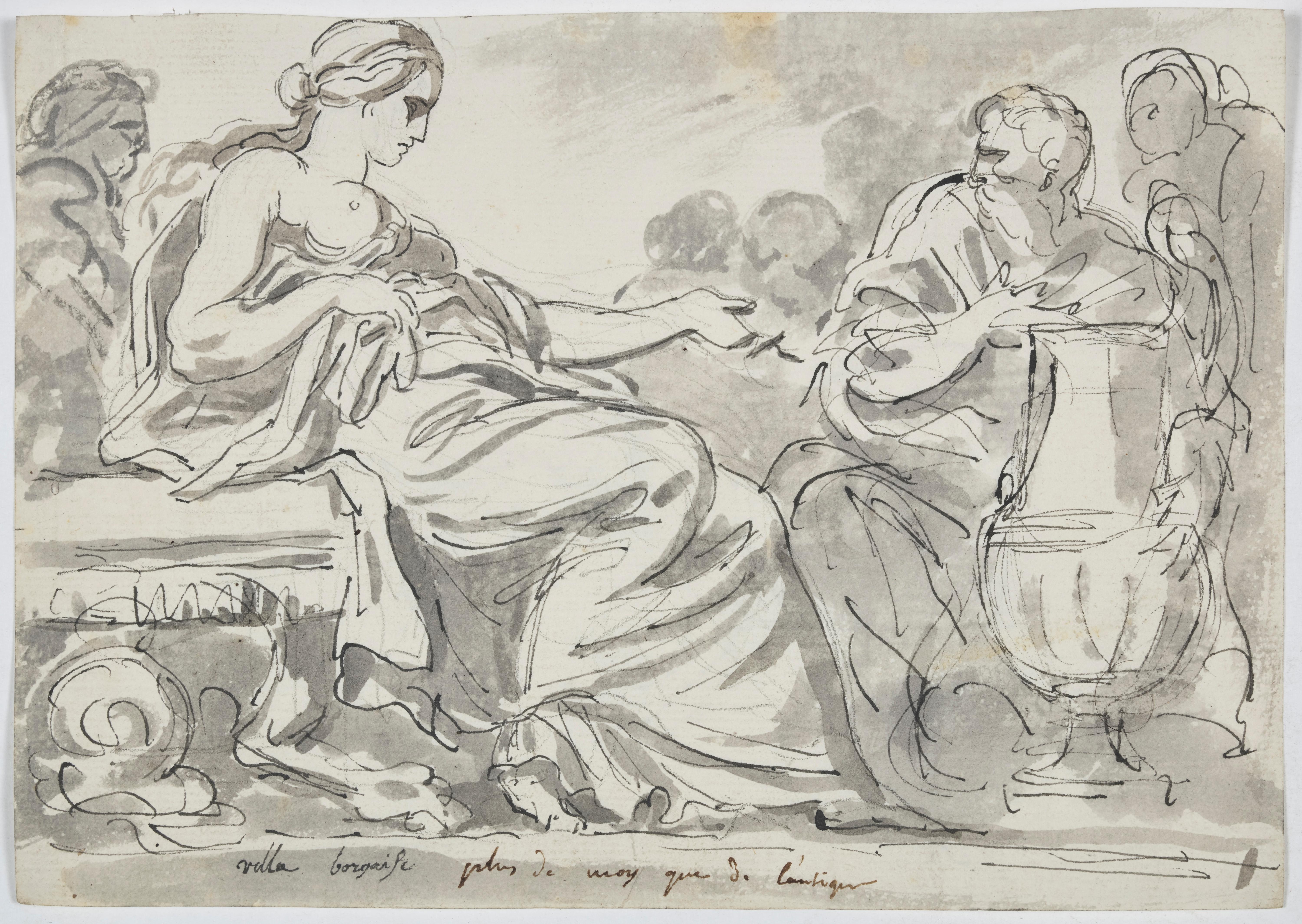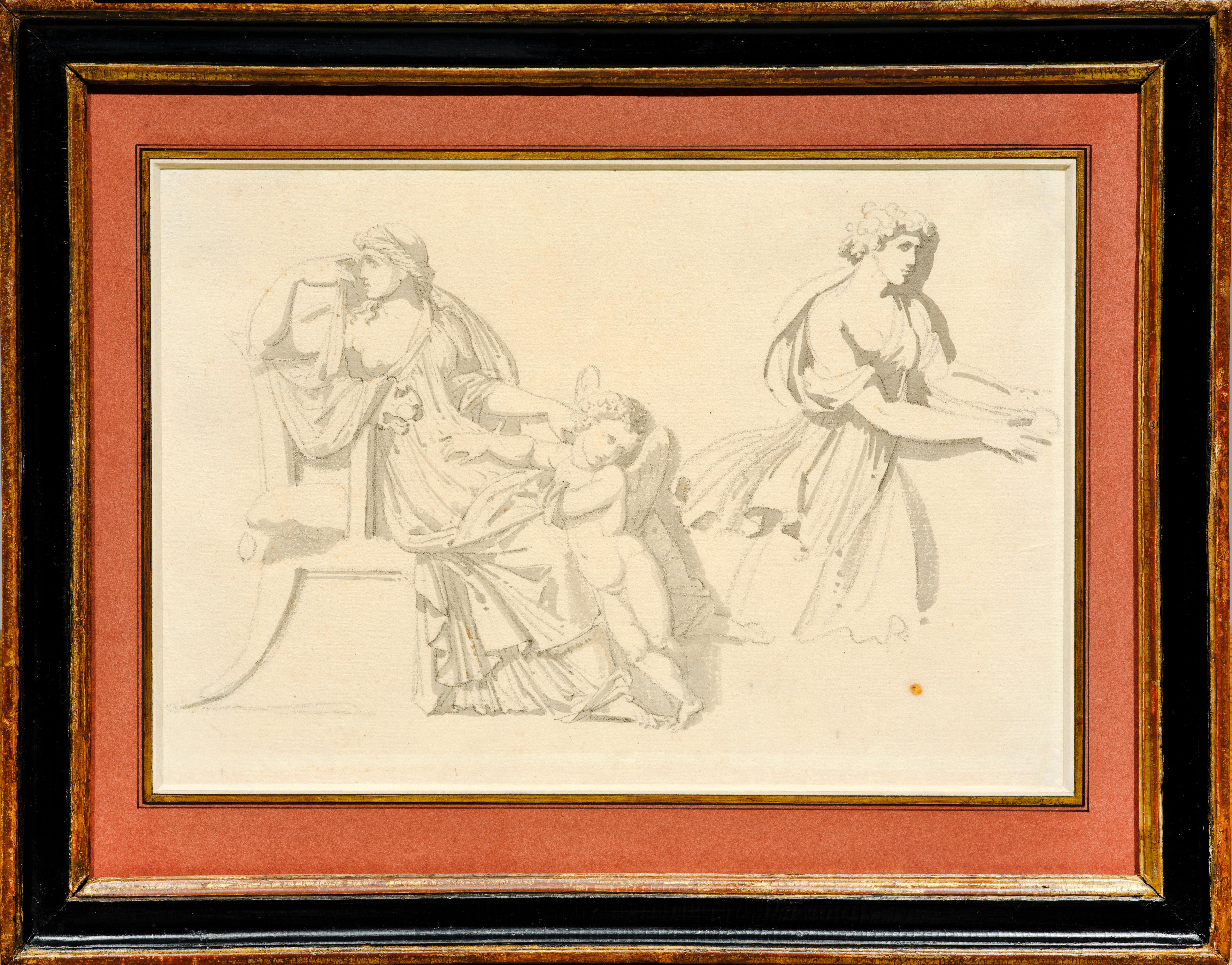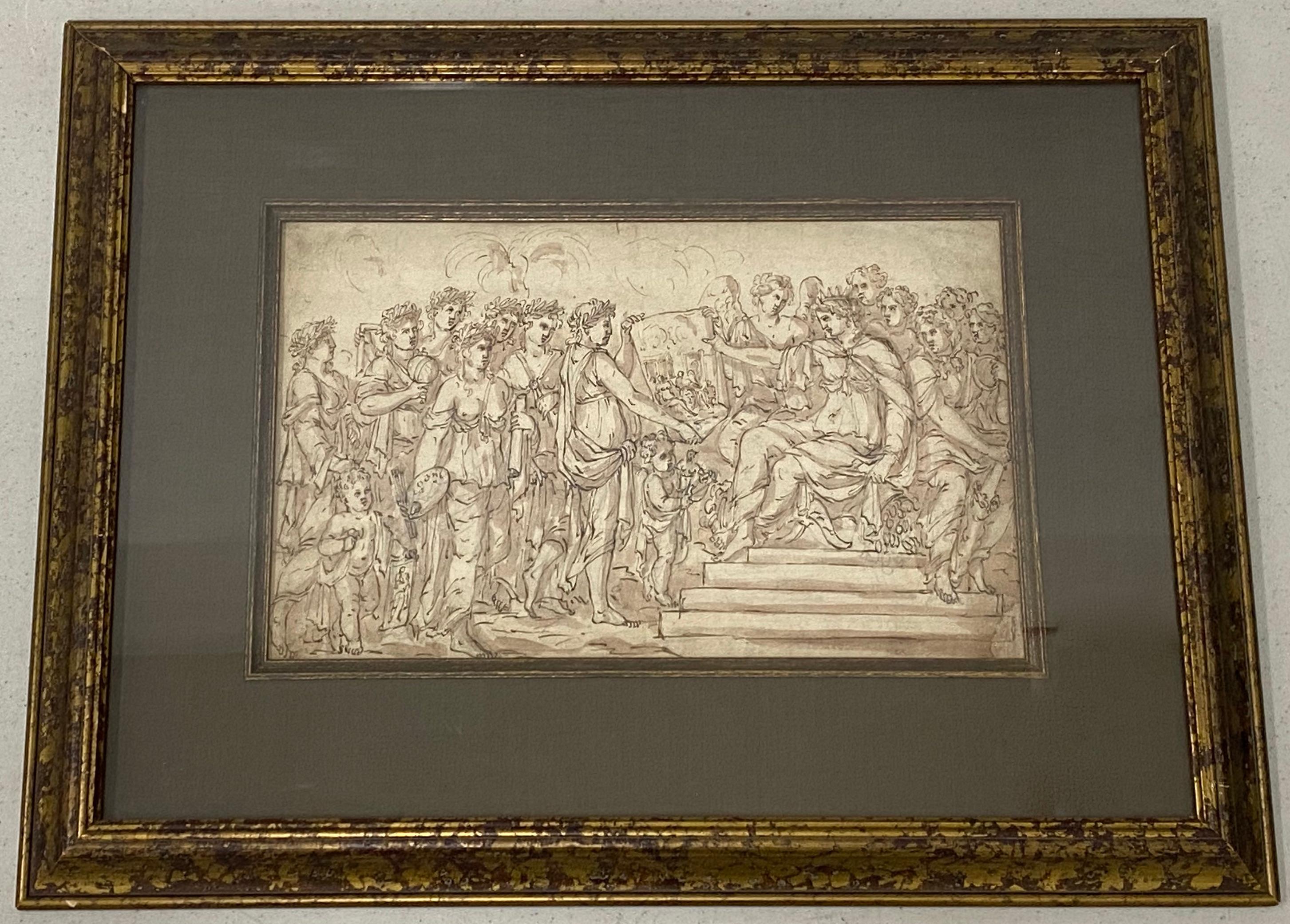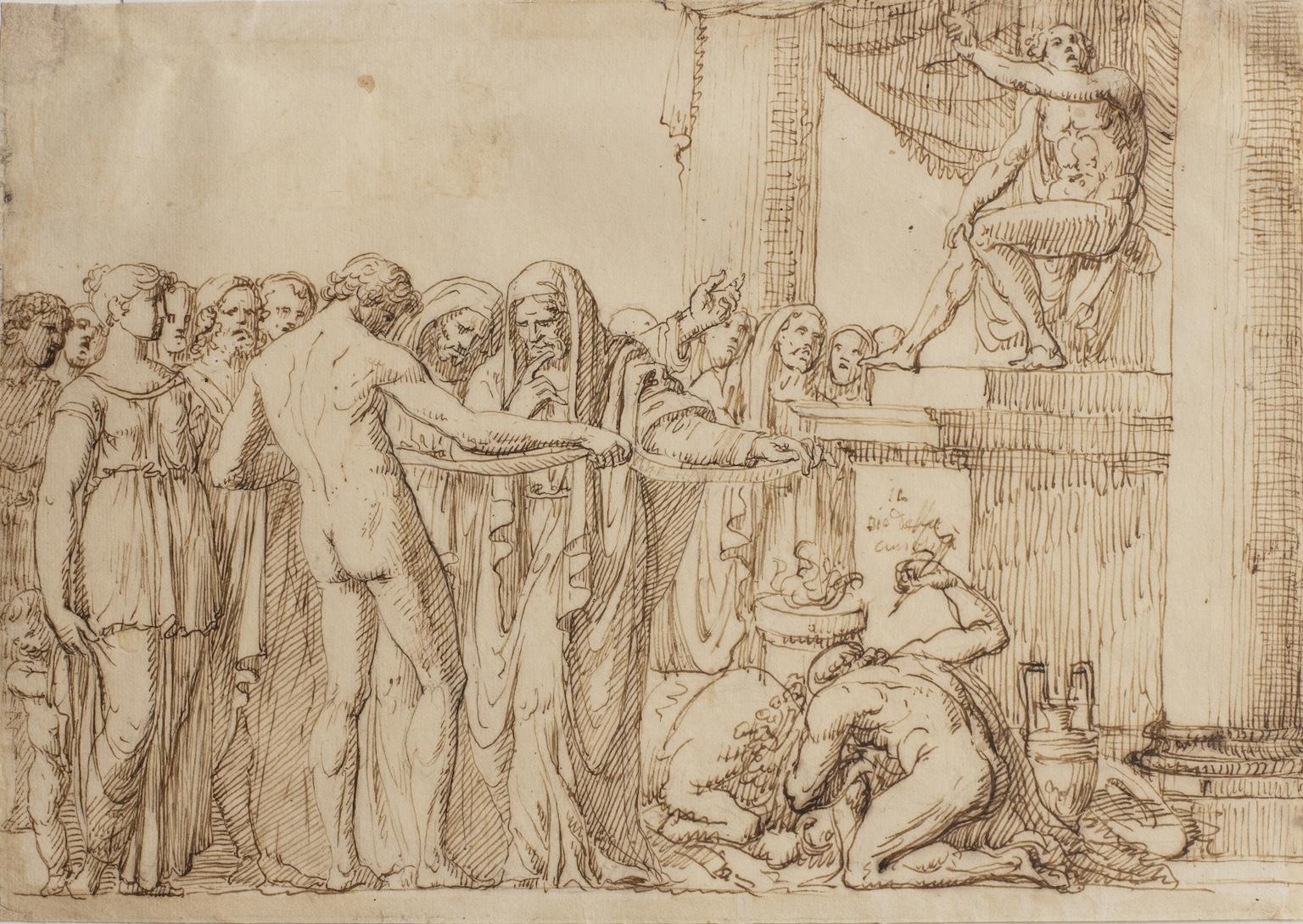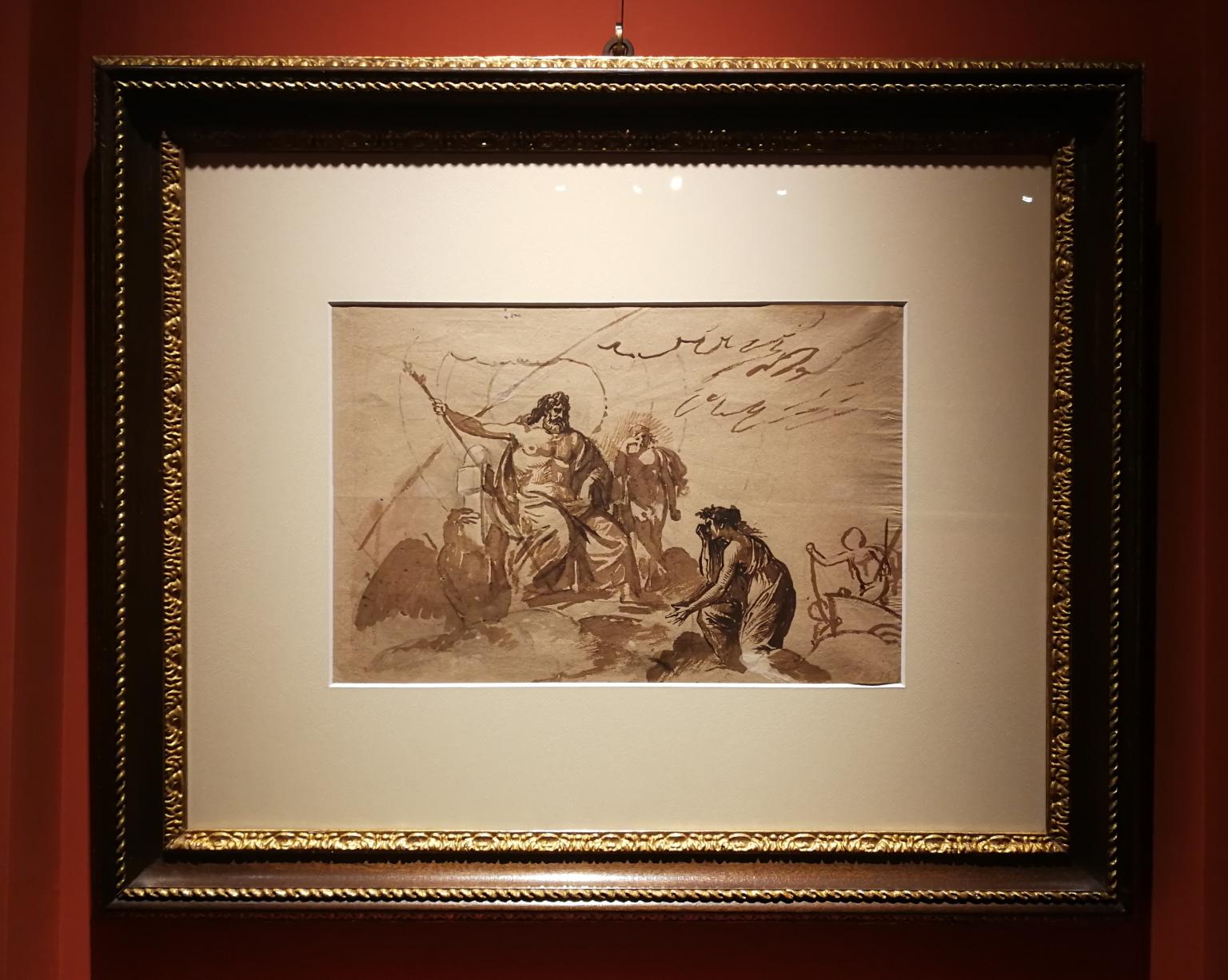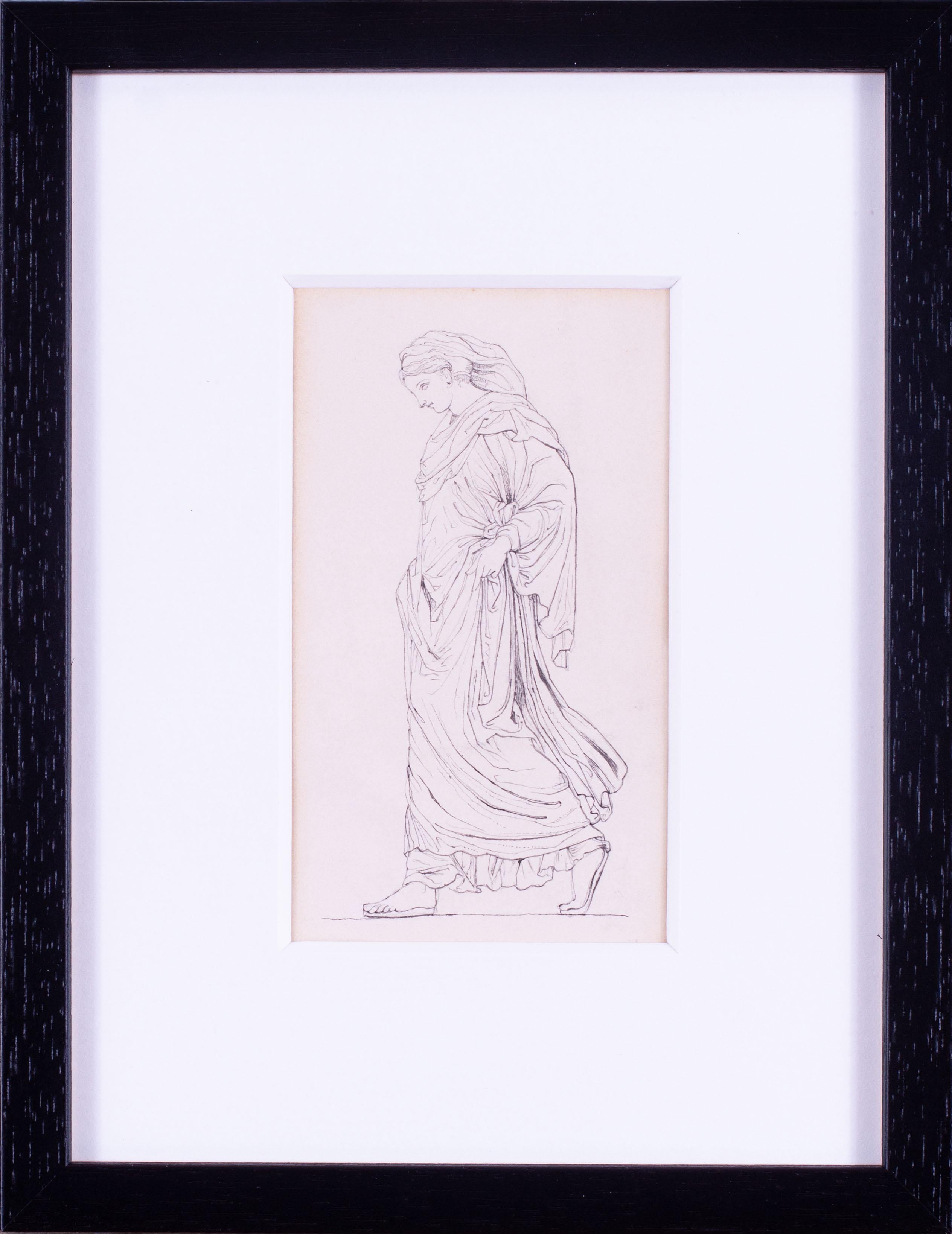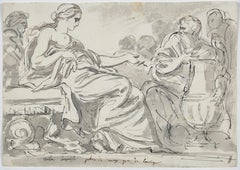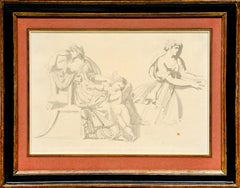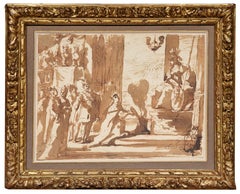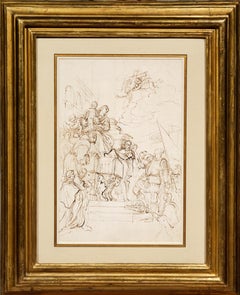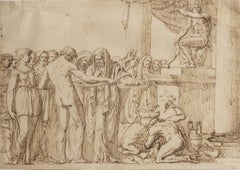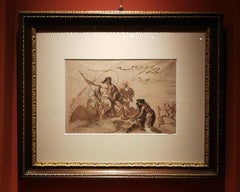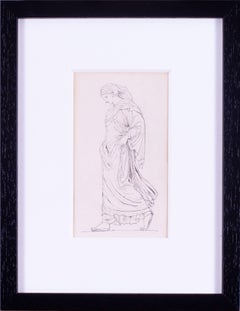Items Similar to A rare neoclassical drawing by Jean-Pierre Péquignot, Girodet's friend
Want more images or videos?
Request additional images or videos from the seller
1 of 15
Jean-Pierre PéquignotA rare neoclassical drawing by Jean-Pierre Péquignot, Girodet's friendca. 1790
ca. 1790
$7,647.05
£5,819.17
€6,500
CA$10,714.18
A$11,668.55
CHF 6,152.42
MX$141,923.25
NOK 77,366.42
SEK 72,563.38
DKK 49,508.13
About the Item
This neoclassical frieze, executed with great meticulousness in pen and ink, is a moving and rare testimony to the work of Jean-Pierre Péquignot, an extremely talented and particularly little-known landscape painter from Franche-Comté (East of France).
Although only about twenty paintings and a few drawings are attributed to him today, Péquignot is best known for his friendship with the painter Anne-Louis Girodet de Roucy-Trioson, whom he met in Rome in 1790 and with whom he fled to Naples in 1793. This friendship had a major influence on Girodet's art, as Péquignot introduced him to landscape painting. However, we will also see that some of Girodet's Neapolitan portraits are quite atypical for this artist, resembling our drawing and suggesting that Péquignot influenced all of Girodet's productions during his Neapolitan period.
Péquignot remained in Naples after Girodet left for Venice in 1794, gradually sinking into poverty and alcoholism. He died abandoned by all in Sorrento around 1807—a true romantic artist's fate!
1. Jean-Pierre Péquignot, an artist's life illuminated by his encounter with Girodet
The son of a blacksmith from Baume-les-Dames, Jean-Pierre Péquignot was trained from the age of ten, along with his brother Antoine (who would become a sculptor), at the Academy of Painting and Sculpture in Besançon. Between 1780 and 1785 they attended the Pawlet Institution, also known as the School for Military Orphans, which enabled them to take drawing classes at the Royal Academy.
Jean-Pierre Péquignot then spent time in David's studio before leaving for Rome in 1788, where he befriended Anne-Louis Girodet de Roucy-Trioson, winner of the Prix de Rome in 1789, who settled there in 1790. Péquignot introduced Girodet to landscape painting, and they often explored the Roman countryside together. On January 13, 1793, a popular uprising in Rome directed against the pro-revolutionary sentiments of the residents and leaders of the French Academy led to its closure and forced Péquignot and Girodet to flee to Naples. It was there that Péquignot met the farmer-general Louis-Adrien Prévost d'Arlincourt, who hired him as a drawing teacher and took him on a trip to Sicily and Malta from March to July 1793.
Returning to Naples, Péquignot was reunited with Girodet and together they explored the sites of the Bay of Naples until Girodet's departure for Venice in March 1794. Left alone in Naples, Péquignot initially enjoyed the protection of a Swiss man in the service of the kings of Naples, Carl-Ludwig-Sébastien Tschudi, before gradually falling into alcoholism and poverty. He died in extreme poverty in Sorrento, probably in 1807.
2. Description of the drawing and related artworks
The body of Péquignot's work known to date is strikingly modest, contrasting with the immense quality of this artist's output. Alongside some twenty known paintings, only one is in a French public collection (at the Musée des Beaux-Arts et d'Archéologie in Besançon) . We have so far identified only one drawing by the artist in a public collection (at the Nationalmuseum in Stockholm). The artist's last painting to be sold, Landscape with Orpheus and Eurydice, nevertheless bears witness to his extreme pictorial refinement.
In this context, it is not surprising that we have not found any work directly related to this frieze, in which two women are depicted back to back, each seated in profile and accompanied by a pedestal that gives rhythm to the composition and refers to their respective activities. This back-to-back representation suggests that it is a study of two characters who are not necessarily related to each other.
On the far left, we first find a smoking altar in front of which stands what appears to be a vestal virgin, her body draped in a large toga, every fold of which is depicted with meticulous precision.
To the right of the Vestal Virgin, behind a half-column supporting a still life composed of objects—fabric samples and a precious vase—arranged in a large basket, a young woman is also seated in the classic pose of Clotho, one of the Parcae: with her arms raised toward the sky, she seems to be pulling toward her a thread whose end is wound around a distaff at her feet.
Clotho's costume, consisting of a fairly close-fitting dress with very tight folds and a headband in her hair, and the still life placed on the pedestal evoke the atmosphere of David's famous painting Brutus, First Consul, Returning Home After Condemning His Two Sons (10th picture of the gallery), composed in 1789, and lead us to date our drawing to around 1790, shortly after the artist's arrival in Rome.
Like the drawing preserved at the Nationalmuseum, our drawing strikes us with the extraordinary precision with which these two female figures are drawn (9th picture of the gallery).
The enlargement of the bust of the vestal virgin (4th picture in the gallery) gives a better idea of the incredible finesse of the pen strokes that intersect to evoke the folds of her clothing and the very particular treatment of the face, using a technique that could almost be described as pointillist !
While Péquignot's influence on Girodet's interest in landscapes during his stay in Italy is well known , we found it interesting to compare the finesse of this work, executed entirely in pen and ink, with a beautiful portrait of Girodet executed in pencil, which we sold in 2024. Although a different technique was used, we find the same dazzling work of cross-hatching and modulation of the face through an infinite number of tiny dots (last picture in the gallery). This portrait, which dates from Girodet's Neapolitan period (1793), also reveals, in our opinion, Péquignot's influence on his work as a portraitist, an influence that allowed Girodet to achieve in this portrait the precision of a miniaturist.
3. Framing
We chose to frame this drawing in an early 19th-century Italian frame made of finely carved natural wood, which nicely complements both the neoclassical style of the drawing and echoes the delicacy of its execution.
Main bibliographical reference:
Emilie Beck Saiello Jean-Pierre Péquignot Baume-les-Dames 1765 – Naples 1807 Editions Artema 2005
- Creator:Jean-Pierre Péquignot (1765 - 1807, French)
- Creation Year:ca. 1790
- Dimensions:Height: 11.75 in (29.85 cm)Width: 19.88 in (50.5 cm)
- Medium:
- Movement & Style:
- Period:1790-1799
- Condition:Dimensions: 6 ½’’ x 15’’ (16.6 x 38 cm) – Framed : 11 ¾’’ x 19 7/8’’ (29.8 x 50.5 cm) Inscription on the back of the old mounting: "Dessins à la Plume par Picquignon” (Pen drawings by Picquignon) Early 19th-century Italian frame.
- Gallery Location:PARIS, FR
- Reference Number:1stDibs: LU1568217150782
About the Seller
5.0
Vetted Professional Seller
Every seller passes strict standards for authenticity and reliability
Established in 2020
1stDibs seller since 2021
10 sales on 1stDibs
- ShippingRetrieving quote...Shipping from: PARIS, France
- Return Policy
Authenticity Guarantee
In the unlikely event there’s an issue with an item’s authenticity, contact us within 1 year for a full refund. DetailsMoney-Back Guarantee
If your item is not as described, is damaged in transit, or does not arrive, contact us within 7 days for a full refund. Details24-Hour Cancellation
You have a 24-hour grace period in which to reconsider your purchase, with no questions asked.Vetted Professional Sellers
Our world-class sellers must adhere to strict standards for service and quality, maintaining the integrity of our listings.Price-Match Guarantee
If you find that a seller listed the same item for a lower price elsewhere, we’ll match it.Trusted Global Delivery
Our best-in-class carrier network provides specialized shipping options worldwide, including custom delivery.More From This Seller
View AllStudy in the Antique Style, a neoclassical drawing by Augustin Pajou
Located in PARIS, FR
In this lively and fresh drawing, probably taken from one of the artist's notebooks, Pajou presents us with a composition freely inspired by antiquity, as a souvenir of a visit to th...
Category
1750s Old Masters Figurative Drawings and Watercolors
Materials
Ink
Frieze of antique figures, a drawing by the sculptor Antoine-Denis Chaudet
Located in PARIS, FR
Faithful to the neo-classical taste, sculptor Antoine-Denis Chaudet presents us with a frieze of antique figures executed in gray wash over pencil strokes, which is likely inspired b...
Category
Early 1800s Old Masters Figurative Drawings and Watercolors
Materials
Paper, Pencil, Ink
Allegory of the Treaty of Angoulême, a drawing attributed to Donato Mascagni
Located in PARIS, FR
We would like to thank Mrs. Ursula Verena Fischer Pace for suggesting the attribution to Donato Arsenio Mascagni.
We were immediately seduced by the rich tonalities of this allegory...
Category
1620s Old Masters Figurative Drawings and Watercolors
Materials
Ink
From Renaissance Venice to Barocco Naples, a drawing by Francesco La Marra
Located in PARIS, FR
This vigorous drawing presents a brilliant synthesis between the Venetian tradition of Titian, of which it is a distant echo, and the Neapolitan Baroque of Solimena, which strongly i...
Category
Mid-18th Century Old Masters Figurative Drawings and Watercolors
Materials
Paper, Ink, Felt Pen
Studies for the Judgment of Solomon, a double-sided drawing by Simone Cantarini
Located in PARIS, FR
In this double-sided red chalk study, Simone Cantarini offers us a double reflection on the theme of the Judgment of Solomon. This sheet reveals his precise style and his sense of de...
Category
1640s Old Masters Figurative Drawings and Watercolors
Materials
Chalk, Laid Paper
Allegory of Chastity, a drawing attributed to G. Porta with great provenance
Located in PARIS, FR
This magnificent drawing from the Venetian Renaissance intrigues us in many ways. It depicts an allegorical composition whose meaning partly escapes us: a veiled figure seated on a stone bench (which we have identified as Chastity), seems to be turning away from a woman's bust beside her, below which are two rabbits, a traditional allegory of fertility, but also sometimes of lust.
This drawing, executed on blue paper, undoubtedly belongs to the Venetian Renaissance. The inscriptions on the back of the old mounting board indicate the various attributions considered by its last owner, the British painter and art historian Sir Lawrence Gowing. We have retained the attribution to Giuseppe Porta proposed by art historian John Arthur Gere as the most relevant.
We were incredibly fortunate to find a hexagonal frame of a very similar format for this drawing, the upper corners of which were formerly cut (irregularly). This 17th-century Dutch frame comes from an aristocratic collection in Lombardy, and creates a kind of fascinating chase around this Venetian drawing...
Category
16th Century Figurative Drawings and Watercolors
Materials
Chalk
You May Also Like
18th to 19th Century "Art Presentation" Old Master Drawing
Located in San Francisco, CA
18th to 19th Century "Art Presentation" Old Master Drawing
Remarkable old master pen, ink and wash drawing of an art presentation
Dimensions 14" wide x 8.5" high
The lightly distr...
Category
Early 19th Century Figurative Drawings and Watercolors
Materials
Ink, Watercolor
Figurative drawing neoclassical Tuscan historical subject from the 19th century
By Francesco Nenci
Located in Florence, IT
The proposed attribution for this drawing in brown ink on paper is the name of the painter and academician of the Tuscan-Roman neoclassical cohort Francesco Nenci (Anghiari, April 19...
Category
Early 19th Century Other Art Style Nude Drawings and Watercolors
Materials
Paper, Ink
Disegno figurativo neoclassico fiorentino del XIX secolo
Located in Florence, IT
Disegno inchiostro, gesso, acquerellature e rialzi a biacca su carta collegato alla serie di studi per la decorazione della Sala di Ercole di Palazzo Pitti a Firenze.
Di mano di Piet...
Category
Early 19th Century Other Art Style Figurative Drawings and Watercolors
Materials
Paper, Ink, Watercolor
19th Century drawing attributed to John Flaxman of a classical maiden
By John Flaxman
Located in Petworth, West Sussex
Attributed to John Flaxman (British, 1755- 1826)
Study of a classical maiden
Pen and ink on paper
5.1/2 x 3.1/8 in. (14 x 8 cm.)
Category
19th Century Academic Figurative Drawings and Watercolors
Materials
Paper, Ink, Pen
Louis-Félix de La Rue (1730-1777) A Mythological scene, drawing
By Louis-Félix Delarue
Located in Paris, FR
Louis-Félix de La Rue (1730-1777)
A Mythological scene
Pen and black ink on paper
Bears an old inscription with the name of the artist on the lower left bo...
Category
1770s Old Masters Figurative Drawings and Watercolors
Materials
Ink
L'Annunziata in S. M. - Drawing by Giovanni Fontana - 16th Century
By Giovanni Fontana
Located in Roma, IT
L'Annunziata in S. M. sopra Minerva is an original old master artwork realized by Giovanni Fontana.
Ivory colored sheet attached on an ivory colored cardboard ( cm 35.8 x 26.7)
Bea...
Category
16th Century Old Masters Figurative Drawings and Watercolors
Materials
Paper, Pencil
$4,323 Sale Price
25% Off
